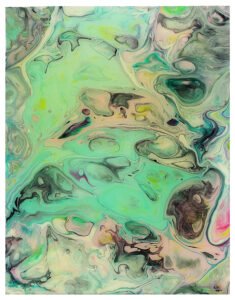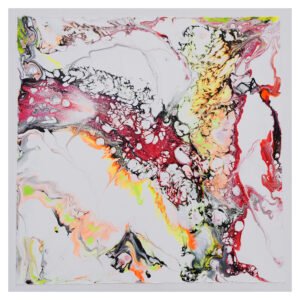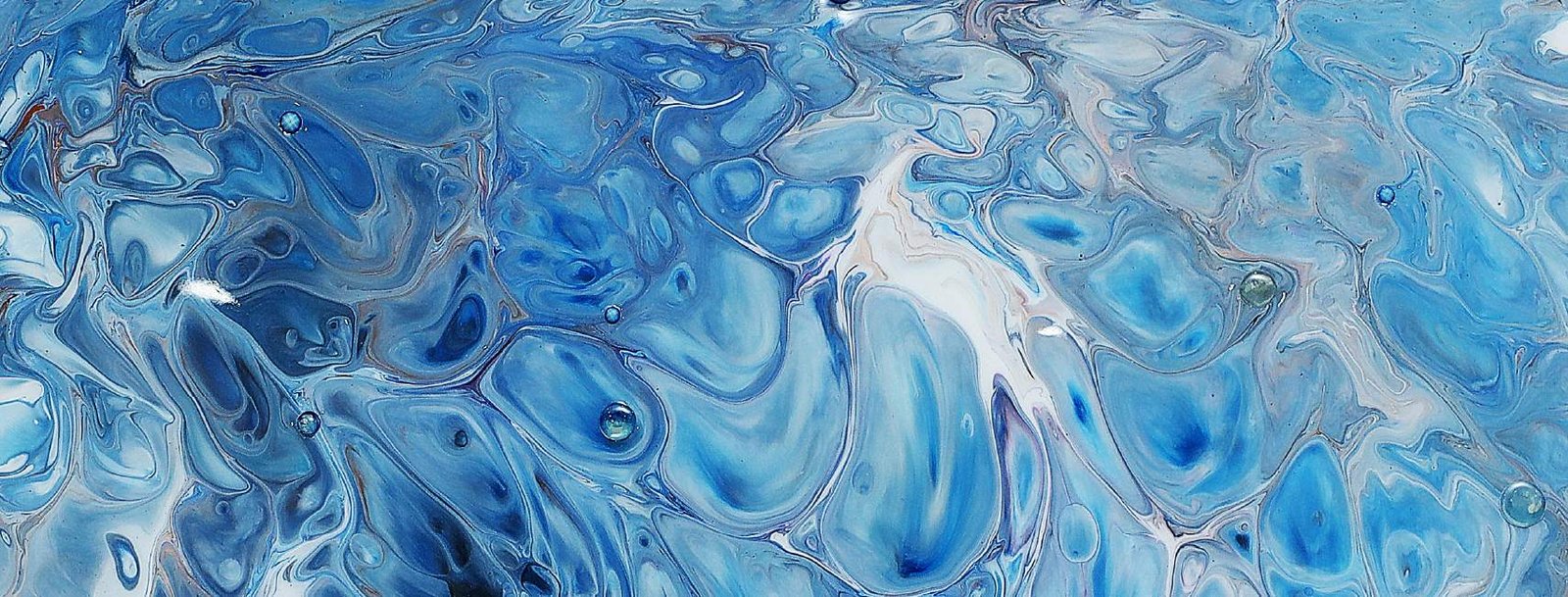Are you afraid that a wrong stroke of your brush will create a mess? Fluid art might be the perfect choice for you.
Understanding Fluid Art
What is Fluid Art?
Fluid art, also known as acrylic pouring, is a type of abstract art that uses fluid paints on a canvas to create organic patterns that blend and come together as a cohesive artwork. Abstract fluid art encompasses various techniques, including acrylic pouring, resin pouring, and more.
The Flow of Creativity
Ever looked out the window and wondered how the natural landscape forms free patterns on its own? The rings on the bark of a tree, the ridges on leaves, or the rhythmic flaps of a bird’s wings – all of these inspire art because, in a way, they are art themselves.
Abstract fluid art allows you the freedom to express yourself spontaneously. It’s a platform where creativity flows freely, without strict planning or constant control. The beauty of fluid art lies in the ability to incorporate surprise elements, letting the art evolve naturally.
Materials Needed for Fluid Art
Canvas – You can choose any canvas shape you prefer, but a square or rectangular canvas is often recommended for beginners as it provides a stable surface for fluid art.
Acrylic paints – The thin, watery consistency of acrylic paints makes them ideal for pouring. Their ability to blend smoothly on the canvas creates the beautiful, fluid patterns that define abstract fluid art.
Pouring medium – A pouring medium is used to thin the acrylic paints and improve the flow. It helps achieve the right consistency, making the paints easier to pour and manipulate without compromising the color integrity.
Plastic cups – Plastic cups are essential for mixing your paints and pouring mediums. They are easy to use, disposable, and can be reused multiple times for different colors and pours.
Additionally, these tools can add unique effects to your fluid art:
Palette knives help you manipulate the paint on the canvas, creating texture or interesting swirls.
Heat guns can be used to enhance the cells and patterns in your fluid art, by heating the paint and allowing it to shift and merge in exciting ways.
Straws can be used to blow the paint in various directions, creating dynamic, flowing patterns.
How to Start Abstract Fluid Art as a Beginner
Step 1: Mix the paint
In a plastic cup, mix the acrylic paint with the pouring medium in a 1:1 ratio. Stir well, then add water to achieve the right consistency. The paint should resemble the consistency of chocolate syrup. Conduct trial pours to test, adjusting as needed.
Step 2: Prepping the canvas
Place your canvas on spare plastic cups to ensure it is leveled. This will allow the paint to flow freely, giving it enough space to move as you tilt the canvas.
Step 3: Pour
Pour your paint mixture onto the canvas, letting it flow naturally. Tilt the canvas in different directions to manipulate the paint, creating the patterns you desire. Feel free to use additional tools like heat guns or palette knives to enhance your artwork and achieve unique effects.
And voila! Your fluid art masterpiece is complete!
Common Mistakes and How to Avoid Them
1. Over-mixing the paint can cause it to lose its fluidity, making it difficult to pour smoothly. The key is to mix the paint and pouring medium gently. Stir until well combined, but avoid overworking the mixture.
2. Pouring the paint too quickly can cause splattering or uneven flow. Instead, pour slowly and steadily, allowing the paint to flow naturally over the canvas. You can always tilt the canvas to adjust the design once the paint is on it.
To avoid these mistakes, follow these checks –
Test Consistency – Make sure your paint mixture is the right consistency (like chocolate syrup). If it’s too thick, it won’t flow properly; if it’s too thin, the paint may be too runny.
Control the Flow – Use tools like palette knives, heat guns, or even straws to control how the paint moves and interacts on the canvas. Tilting the canvas in different directions allows you to shape the design as you wish.
Patience – Fluid art is all about letting things flow. Give the paint time to settle and evolve, and don’t rush the process.
From Concept to Creation: A Finished Fluid Art Piece


Let these stunning artworks elevate your home’s aesthetic!
The Appeal of Abstract Fluid Art
Fluid art stands out because of its ability to create unpredictable, organic results that blend modern aesthetics with timeless appeal. Unlike traditional forms of art, fluid art allows the canvas to dictate the flow of creativity, creating an artwork that is unique each time. The unpredictable nature of fluid art mirrors life itself, often messy, yet beautiful in its spontaneity and unexpected outcomes.
Fluid art goes beyond just being a visual experience, it’s an emotional and psychological journey. The act of creating fluid art is inherently therapeutic. As the paint flows and interacts with itself on the canvas, the artist is drawn into the present moment, allowing them a break from the pressures of daily life. Abstract fluid art provides a creative outlet and a way to release emotions and reconnect with one’s inner self.
Embrace the Flow: Unleashing Creativity and Wellness Through Fluid Art
Fluid art is a joyful and relaxing experience for the creator, offering a fresh and unique perspective on art and its many forms. While modern in style, it is beginner-friendly, requiring nothing more than a canvas, paints, and a vision to bring it to life.
Abstract fluid art opens the door for anyone to explore their creative side, just like our very own Lachman Ludhani, the Chairman and Managing Director of Evershine Group. His painting Windborne Blessings is now seeking its forever home and you have the opportunity to bring this masterpiece from the shelves to your walls. Don’t miss out on making it a part of your space!

